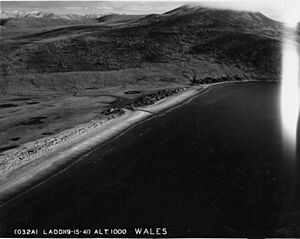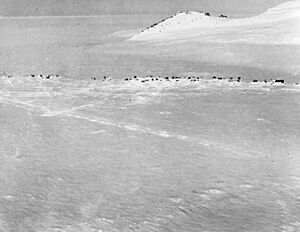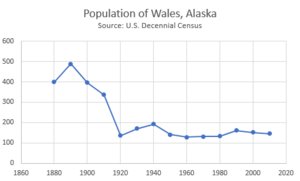Wales, Alaska facts for kids
Quick facts for kids
Wales
Kiŋigin (Inupiaq)
|
|
|---|---|

View of the Wales Site, with the city of Wales in the background
|
|
| Nickname(s):
Kingegan
|
|
| Country | United States |
| State | Alaska |
| Census Area | Nome |
| Incorporated | April 16, 1964 |
| Area | |
| • Total | 2.30 sq mi (5.97 km2) |
| • Land | 2.30 sq mi (5.97 km2) |
| • Water | 0.00 sq mi (0.00 km2) |
| Elevation | 26 ft (8 m) |
| Population
(2020)
|
|
| • Total | 168 |
| • Density | 72.92/sq mi (28.16/km2) |
| Time zone | UTC-9 (Alaska (AKST)) |
| • Summer (DST) | UTC-8 (AKDT) |
| ZIP code |
99783
|
| Area code | 907 |
| FIPS code | 02-82860 |
| GNIS feature ID | 1404755, 2418870 |
Wales (which is called Kiŋigin by the local Inupiat) is a small city in the Nome Census Area, Alaska, United States. It is famous for being the westernmost city on the North American mainland.
In 2020, about 168 people lived there. You can fly to Wales through Wales Airport with airlines like Bering Air and Ravn Alaska, usually from Nome.
Contents
History of Wales
Early History and Settlements
A very old burial mound was found near Wales. It dates back to the Birnirk culture, which lived there between 500 and 900 AD. This site is now a National Historic Landmark.
In 1827, a report from the Russian Navy mentioned two Inupiat villages in the area. One was called "Eidamoo" near the coast, and the other was "King-a-ghe" further inland.
Growth and Challenges
In 1890, a group called the American Missionary Association started a mission where Wales is today. In the 1890s, reindeer (which are domesticated caribou) were brought to the area. A reindeer station was set up in 1894.
Wales became an important place for whaling. This was because it was located along the routes that whales used to travel. It grew into the biggest and richest village in the region, with over 500 people living there. The city of Wales is named after the country Wales.
Sadly, the 1918 flu pandemic hit Wales very hard. It caused a big drop in the population and hurt the local economy.
Modern Developments and Events
In 2002, a new power system started working in Wales. It uses both wind power and diesel fuel to create electricity.
On November 9, 2011, a very strong storm called the 2011 Bering Sea superstorm hit the city. Winds were recorded blowing as fast as 89 miles per hour.
On January 17, 2023, a polar bear entered the community. It attacked a woman and her young child. A local resident shot and killed the bear. This was the first reported polar bear attack in Alaska in over 30 years.
Geography and Location
Wales is located at 65°36′44″N 168°5′21″W / 65.61222°N 168.08917°W. It sits on the very westernmost point of the American mainland, called Cape Prince of Wales. This spot is on the western tip of the Seward Peninsula.
It is also at the northern end of the Continental Divide. This is where the waters of the Pacific Ocean and the Arctic Ocean meet. Wales is about 111 miles (179 km) northwest of Nome.
The city covers a total area of about 2.8 square miles (7.3 square kilometers). All of this area is land.
Population Changes
| Historical population | |||
|---|---|---|---|
| Census | Pop. | %± | |
| 1880 | 400 | — | |
| 1890 | 488 | 22.0% | |
| 1900 | 396 | −18.9% | |
| 1910 | 337 | −14.9% | |
| 1920 | 136 | −59.6% | |
| 1930 | 170 | 25.0% | |
| 1940 | 193 | 13.5% | |
| 1950 | 141 | −26.9% | |
| 1960 | 128 | −9.2% | |
| 1970 | 131 | 2.3% | |
| 1980 | 133 | 1.5% | |
| 1990 | 161 | 21.1% | |
| 2000 | 152 | −5.6% | |
| 2010 | 145 | −4.6% | |
| 2020 | 168 | 15.9% | |
| U.S. Decennial Census | |||
Wales first appeared in the U.S. Census in 1880. Back then, it was an unincorporated Inuit village called "Kingigamute." In 1890, it was listed as "Kingaghee." For the 1900 and 1910 censuses, it was called Cape Prince of Wales (Settlements). In 1920, its name was shortened to Wales. The city officially became incorporated in 1964.
In 2000, there were 152 people living in Wales. Most of the people living in the city were Native American (83.55%).
The average household in Wales had about 3 people, and the average family had about 4.4 people. Many households (38%) had children under 18 living with them.
Climate
Wales has a polar climate, which means it is very cold for most of the year. This type of climate is also known as a tundra climate.
| Climate data for Wales, Alaska (1971–2000 normals, extremes 1925–1995) | |||||||||||||
|---|---|---|---|---|---|---|---|---|---|---|---|---|---|
| Month | Jan | Feb | Mar | Apr | May | Jun | Jul | Aug | Sep | Oct | Nov | Dec | Year |
| Record high °F (°C) | 53 (12) |
49 (9) |
42 (6) |
48 (9) |
57 (14) |
72 (22) |
75 (24) |
73 (23) |
66 (19) |
54 (12) |
67 (19) |
44 (7) |
75 (24) |
| Mean maximum °F (°C) | 35.1 (1.7) |
30.1 (−1.1) |
30.2 (−1.0) |
34.7 (1.5) |
44.8 (7.1) |
57.4 (14.1) |
63.7 (17.6) |
61.5 (16.4) |
53.3 (11.8) |
43.0 (6.1) |
37.7 (3.2) |
33.3 (0.7) |
65.2 (18.4) |
| Mean daily maximum °F (°C) | 7.2 (−13.8) |
4.3 (−15.4) |
5.4 (−14.8) |
16.0 (−8.9) |
32.2 (0.1) |
43.4 (6.3) |
51.9 (11.1) |
51.0 (10.6) |
44.1 (6.7) |
32.6 (0.3) |
22.0 (−5.6) |
9.9 (−12.3) |
26.7 (−2.9) |
| Daily mean °F (°C) | 3.0 (−16.1) |
−2.5 (−19.2) |
−1.4 (−18.6) |
9.7 (−12.4) |
27.5 (−2.5) |
38.5 (3.6) |
47.4 (8.6) |
47.0 (8.3) |
40.5 (4.7) |
28.6 (−1.9) |
16.5 (−8.6) |
3.8 (−15.7) |
21.5 (−5.8) |
| Mean daily minimum °F (°C) | −6.7 (−21.5) |
−9.3 (−22.9) |
−8.2 (−22.3) |
3.4 (−15.9) |
22.8 (−5.1) |
33.5 (0.8) |
42.9 (6.1) |
43.0 (6.1) |
36.8 (2.7) |
24.6 (−4.1) |
10.9 (−11.7) |
−2.3 (−19.1) |
16.0 (−8.9) |
| Mean minimum °F (°C) | −27.0 (−32.8) |
−30.5 (−34.7) |
−28.2 (−33.4) |
−16.7 (−27.1) |
4.2 (−15.4) |
25.6 (−3.6) |
34.8 (1.6) |
36.1 (2.3) |
28.1 (−2.2) |
9.7 (−12.4) |
−8.0 (−22.2) |
−20.9 (−29.4) |
−33.3 (−36.3) |
| Record low °F (°C) | −44 (−42) |
−44 (−42) |
−42 (−41) |
−32 (−36) |
−11 (−24) |
20 (−7) |
23 (−5) |
30 (−1) |
19 (−7) |
−7 (−22) |
−28 (−33) |
−35 (−37) |
−44 (−42) |
| Average precipitation inches (mm) | 0.41 (10) |
0.45 (11) |
0.48 (12) |
0.27 (6.9) |
0.54 (14) |
0.73 (19) |
1.47 (37) |
2.46 (62) |
1.99 (51) |
1.41 (36) |
0.68 (17) |
0.52 (13) |
11.41 (290) |
| Average snowfall inches (cm) | 4.1 (10) |
3.8 (9.7) |
4.5 (11) |
3.3 (8.4) |
2.2 (5.6) |
0.2 (0.51) |
0.2 (0.51) |
0.0 (0.0) |
1.4 (3.6) |
6.2 (16) |
7.7 (20) |
4.6 (12) |
38.2 (97.32) |
| Source 1: NOAA (normals, 1971–2000), Weather.com (extremes) | |||||||||||||
| Source 2: WRCC | |||||||||||||
Education
The Bering Strait School District provides education in Wales. The Wales Kingikmiut School teaches students from Pre-Kindergarten all the way through 12th grade.
See also
 In Spanish: Wales (Alaska) para niños
In Spanish: Wales (Alaska) para niños





